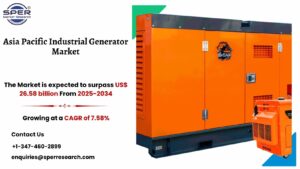United States Warehouse Robotics Market Share 2024- Industry Trends, Revenue, Growth Drivers, Key Players, Business Challenges, Opportunities and Future Competition till 2033: SPER Market Research

Warehouse robots are self-driving or semi-autonomous machines that perform a range of tasks at warehouses or distribution centres. These robots use sensors, cameras, and complicated navigation algorithms to navigate the warehouse, interact with items, and perform tasks efficiently. Warehouse robots can perform duties such as material handling, order fulfilment, inventory management, palletizing and depalletizing, sorting, cleaning and maintenance, and security. Warehouse robots offer numerous advantages, including enhanced efficiency, productivity, and precision. These robots can work around the clock and perform repetitive tasks far faster than humans, resulting in a significant gain in operational efficiency. Furthermore, they contribute to cost savings by minimising errors and automating labour-intensive processes across a wide range of businesses.
According to SPER Market Research, ‘United States Warehouse Robotics Market Size- By Type, By Function, By End User – Regional Outlook, Competitive Strategies and Segment Forecast to 2033’ states that the US Warehouse Robotics Market is estimated to reach USD 19.52 billion by 2033 with a CAGR of 11.83%.
Drivers:
The workforce shortage in the warehousing and logistics business is a primary motivator for the adoption of warehouse robots. As labour markets tighten and wages rise, businesses have the challenge of maintaining efficient operations while limiting employment costs. Warehouse robots are a cost-effective solution that eliminates the need for human labour, particularly in repetitive and physically demanding tasks. These robots may operate around the clock, eliminating issues like as shift-based employment, sick leave, and turnover. Businesses can increase operational efficiency by automating activities such as material handling, palletizing, and order processing, while simultaneously addressing workforce constraints.
Restraints:
A significant upfront cost associated with robotic system adoption is one of the primary challenges facing the US warehouse robotics business. Even though warehouse robotics provide several long-term advantages, such as increased productivity and lower operational costs, many organisations, particularly small and medium-sized businesses (SMEs), may find them difficult to use. Apart from the robotic equipment, the expenses include staff training, software development, system integration, and facility improvements required to accommodate the new technology. Businesses may need to pay consultants and professionals to plan and develop the robot deployment, which would add to the overall cost.
Request For Free Sample Report @ https://www.sperresearch.com/report-store/united-states-warehouse-robotics-market.aspx?sample=1
Impact of COVID-19 on United States Warehouse Robotics Market
The warehouse robotics market has been greatly impacted by the COVID-19 outbreak in a number of ways. The virus pandemic caused an abrupt spike in demand for online retail, e-commerce, and necessities. It was extremely difficult for warehouses and distribution centres to handle this increased demand while maintaining safety precautions and social separation. As a result, businesses started implementing warehouse robotics more quickly in an effort to automate processes and minimise human interaction within their buildings. More money is being spent on research and development as a result of the increase in demand for robotics solutions, which has produced more sophisticated and effective robotics technology.
United States Warehouse Robotics Market Key Players:
The Midwest dominated the United States Warehouse Robotics Market, and this dominance is likely to continue during the forecast period. The Midwest region, which includes the states of Illinois, Ohio, Michigan, and Indiana, is critical to the warehousing and logistics industry. Major players in the market are Zebra Technologies Corp, GreyOrange Pte Ltd, Locus Robotics Corporation, inVia Robotics, Inc, FANUC America Corporation, and Others.
United States Warehouse Robotics Market Segmentation:
The SPER Market Research report seeks to give market dynamics, demand, and supply forecasts for the years up to 2033. This report contains statistics on product type segment growth estimates and forecasts.
By Type: Based on the Type, United States Warehouse Robotics Market is segmented as; Articulated, Gantry, Automated Storage and Retrieval System (ASRS), Mobile, Others.
By Function: Based on the Function, United States Warehouse Robotics Market is segmented as; Storage, Trans-shipments, Packaging, Others.
By End User: Based on the End User, United States Warehouse Robotics Market is segmented as; Food and Beverages, Automotive, Retail, Electronics and Electrical, Pharmaceuticals, Others.
By Region: This research also includes data for North, South, West, Mideast.
This study also encompasses various drivers and restraining factors of this market for the forecast period. Various growth opportunities are also discussed in the report.
For More Information, refer to below link:-
US Warehouse Robotics Market Revenue
Related Reports:
Follow Us –
LinkedIn | Instagram | Facebook | Twitter
Contact Us:
Sara Lopes, Business Consultant – U.S.A.
SPER Market Research
+1-347-460-2899





